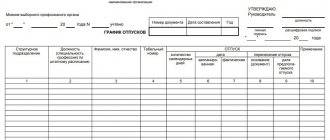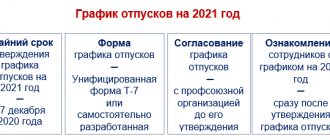Drawing up a vacation schedule is the responsibility of all employers, regardless of the number of employees in the company. This document regulates the order of provision of paid leave in the calendar year and contains information about the time of distribution of rest for employees (Article 123 of the Labor Code of the Russian Federation). When compiling it, the wishes of employees and the peculiarities of the work process are taken into account. Employers must have time to draw up a vacation schedule by December 17.
- Features of vacation scheduling
- How to indicate the start date of a vacation in the vacation schedule
- On the right to transfer vacation to the next year
- Vacation schedule form
- Changing the vacation schedule
- The employee will be laid off in January. Do I need to fill out a vacation schedule for him?
- Penalty for not having a vacation schedule
Features of vacation scheduling
The procedure for drawing up a vacation schedule can be established in a collective agreement, internal labor regulations or other local regulations. Moreover, Rostrud believes that each structural unit may have its own vacation schedule. This is especially true for large companies with hundreds or thousands of employees. In this case, the heads of departments prepare draft schedules, and then transfer the document to personnel officers, who, for their part, form a consolidated unified vacation schedule.
According to the accepted rule, the vacation schedule must contain information about the time and duration of vacation for each employee working under an employment contract.
Typically, the length of leave depends on the number of vacation days to which the employee is entitled and the number of unused vacation days as of January 1, 2021.
When drawing up a vacation schedule, do not forget about newcomers who have not worked for six months at the beginning of the calendar year. As we know, the right to use vacation for the first year of work arises after six months of continuous work with a particular employer. Therefore, when drawing up a schedule, it is important to take into account that newcomers can take advantage of the required rest days by the end of 2021.
Duration of basic annual leave for different categories of employees
- 28 calendar days (Article 115 of the Labor Code of the Russian Federation) - for all employees not classified as preferential categories;
- 31 calendar days (Article 267 of the Labor Code of the Russian Federation) - for workers under 18 years of age;
- 30 calendar days (Federal Law of November 24, 1995 No. 181-FZ) - for disabled people;
- 30-40 days (Federal Law No. 151-FZ dated August 22, 1995) - for rescue service workers (depending on the length of continuous work);
- 42-56 calendar days (Federal Law No. 136-FZ dated November 7, 2000; Decree of the Government of the Russian Federation dated May 14, 2015 No. 466) - for workers engaged in work with chemical weapons, certain categories of teaching staff.
There are several categories of employees who “stand out” from the general rule for drawing up a vacation schedule:
1. Employees who have the right to apply for paid leave upon application before the expiration of six months of continuous work.
Such employees are specified in Art. 122 Labor Code of the Russian Federation:
- women - before maternity leave or immediately after it;
- workers under 18 years of age;
- employees who adopted a child under 3 months of age.
According to Art. 123 of the Labor Code of the Russian Federation, at the request of the employee, he may be granted annual leave while his wife is on maternity leave, regardless of the time of his continuous work with the employer.
2. Part-timers.
According to Art. 286 of the Labor Code of the Russian Federation, leave for part-time workers is granted simultaneously with leave at the main place of work. If an employee has not worked for six months at a part-time job, then leave is granted in advance.
To take this category of employees into account in the vacation schedule, ask them for information about the vacation period at their main place of work.
3. Employees with many children with children under 12 years old.
Federal Law No. 360-FZ dated October 11, 2018 supplemented the Labor Code with Art. 262.2. Now employers need to take into account that parents of 3 or more children under the age of 12 have the right to take annual paid leave at their request at a time convenient for them.
The Letter of the Ministry of Labor of the Russian Federation dated November 20, 2018 N 14-2 / OOG-9166 clarifies that the age of children is calculated based on the year of leave. This means that if at the beginning of the year the leave was granted, an employee with many children had the right to use the leave at a convenient time, then this right is retained even if the eldest child is already 12 years old at the time the leave begins.
Automatic payroll for each employee - just confirm the amounts. Calculate sick leave and vacation in a few minutes.
Try it
In a review of current issues for February 2021, Rostrud considered the question of whether an employee with three children under the age of 12 can take leave at a convenient time in parts. According to experts, the right to use vacation at a convenient time does not mean the right to divide the vacation into parts at the request of the employee. Such division in accordance with Art. 125 of the Labor Code of the Russian Federation is possible only by agreement of the parties. In this case, one of the parts of the vacation must be at least 14 calendar days.
4. Veterans, employees awarded the “Honorary Donor of Russia” badge, employees raising a disabled child under the age of 18, spouses of military personnel.
All these categories of workers have the right to go on paid leave at a time convenient for them.
When drawing up a vacation schedule for 2021, it is important to remember that non-working holidays, which are specified in Art. 112 of the Labor Code of the Russian Federation, are not included in the number of calendar days of annual main or additional leave. Therefore, if a vacation falls on these days, its end date is automatically postponed.
In addition, it is important to remember about the postponement of holidays in 2021 (Resolution of the Government of the Russian Federation of October 10, 2020 No. 1648).
The right to long rest at the request of certain categories of workers
Not in every situation, the provision of annual paid leave is carried out on the basis of the consent of the parties. Conditions of Art. 122 of the Labor Code of the Russian Federation establish certain categories of employees to whom this period should be provided on the basis of applications and, in a number of situations, attached documents.
These include the following employees:
- women in connection with their pregnancy or childbirth. They have the right to early first leave before the same prenatal period, or after its end. This is due to both medical and social reasons. These conditions are provided in order to ensure the normal development of the child.
- The situation is similar with employees who adopted a child who is no more than 3 months old. In the initial stages it requires considerable attention.
- Minor employees have this right. This is also due to medical reasons, since rest is required for the development of the body.
This list is characterized by openness and allows for other legal grounds. These include the following conditions:
- the right to an early annual paid vacation period for male employees whose spouses are approaching childbirth or have recently completed it (Article 123 of the Labor Code of the Russian Federation). This is due to measures to protect families, since at such times a woman’s opportunities are significantly limited.
- Art. 262.1 of the Labor Code of the Russian Federation, among additional guarantees, establishes the right of the legal representatives of a disabled child to receive annual leave ahead of schedule. This is explained by the need for increased attention to such children.
- An advance period is provided to part-time workers. This is due to the need for full implementation of the relevant right. A special provision of the law (Article 286 of the Labor Code of the Russian Federation) establishes the principle of dependence of rest at an additional place of work on a similar period at the main one.
On the right to transfer vacation to the next year
It is quite possible that when drawing up a vacation schedule for 2021, some employee will send you an application asking not to grant him vacation next year, but to postpone it to 2022. This request must be answered with a refusal. This is what Rostrud experts advise to do.
They refer to the fact that paid annual leave must be provided every year. And if the transfer is allowed, it is only in exceptional situations (Article 124 of the Labor Code of the Russian Federation), which include, for example, production necessity and temporary disability of the employee.
When should leave be granted?
The general rules for providing such a period to an employee are set out at the very beginning of Art. 122 Labor Code of the Russian Federation. The current procedure provides for paid vacations annually. At the same time, it is not the calendar year that matters, but the working year. The latter is calculated from the date of issuance of the order for admission, or from another moment when such relations arise. The employer must monitor the correctness of calculation of these deadlines for each employee individually.
If the date of admission is April 4, then each working period that serves as the basis for providing annual paid leave will end on April 3 of the following year.
Current regulations determine the employer’s obligation to provide this time to the employee within the period specified above. Failure to comply with this rule is a serious violation of labor legislation. It is very simple to establish, since both the very fact of being sent on paid leave and its duration are reflected in the financial documentation.
To avoid conflicts within the team, as well as to ensure a stable position in the functioning of the organization, it is planned to draw up a vacation schedule. Employees must be aware in advance of the time period during which this period will occur. This position allows them to decide in advance on the place and method of their vacation.
Vacation schedule form
When drawing up a vacation schedule, you can use form T-7 (Resolution of the State Statistics Committee of the Russian Federation dated April 6, 2001 No. 26). At the vacation planning stage, columns 1 to 6 should be filled out.
Column 6 contains the start date of vacation for employees, including those who have the right to take vacation at any time convenient for them.
Columns 7, 8 and 9 are not filled in. Data is entered into them by hand throughout the year, as employees go on vacation.
Rostrud recommends adding an additional column “I am familiar with the schedule” to the form or drawing up a familiarization sheet, which will be an appendix to the vacation schedule. Do not forget that, according to Art. 123 of the Labor Code of the Russian Federation, each employee must be notified of the start time of vacation no later than two weeks before its start.
Until approval, the vacation schedule is just a draft. After it has been endorsed by the head of the personnel service and the heads of structural divisions, the document is sent to the trade union organization (Article 372 of the Labor Code of the Russian Federation). Its confirmation is expressed in the format of an extract from the minutes of the meeting of the trade union committee. But today not every company has a trade union. Then you need to make a note about this in the approval line of the form.
Employees must be familiarized with the approved vacation schedule against signature. The document follows:
- store in the accounting and personnel departments;
- post in a convenient place for reference;
- send to the structural divisions of the company (copies of the schedule).
If the employer warned the employee about the start of the vacation later than two weeks before its start, the employee has the right to submit a written application requesting to postpone the vacation to another agreed date. At the same time, he may not write an application addressed to the employer to grant him leave if he uses it in accordance with the schedule.
There are several cases when an employee is required to apply for leave:
- vacation is used before six months of continuous work with the employer;
- vacation is used before six months of continuous work based on an agreement with the employer;
- the employee belongs to one of the categories to whom the employer is obliged to provide leave at a convenient time.
Leaving ahead of schedule
The law provided for a category of persons who can take advantage of the right to annual leave before 6 months of continuous service .
Art. 122 of the Labor Code of the Russian Federation refers to them:
- minor citizens;
- employees who adopted a child under 3 months of age;
- women who go on maternity leave or, conversely, return after it.
Federal laws expanded this list and granted the right to early leave to the following categories of persons:
- Employees who are raising a disabled child;
- Single mothers or fathers with two or more children under 12 years of age;
- Military spouses;
- Persons called back from their main leave ahead of schedule;
- Part-time employees if they have taken leave from their main place of work.
In all of these cases, the employer does not have the right to refuse to provide early paid leave. It will be enough to submit an application indicating the official reason and attaching supporting documents.
The employer has the opportunity to voluntarily send an employee on annual leave ahead of schedule, that is, provide leave in advance .
A situation may arise where an employee took advantage of this opportunity and then decided to quit and did not actually work the allotted time. By law, up to 20% of his earnings can be withheld as compensation for losses incurred.
The order in which employees go on annual leave is determined by a schedule in the T-7 form, which is approved by the organization no later than two weeks before the start of the new year . If a new employee has the right to early leave and has expressed a desire to take advantage of it, then the schedule is adjusted to take into account the changes.
Changing the vacation schedule
Since the vacation schedule is a mandatory document not only for the employer, but also for the employee, if changes are made to it, agreement of the parties is required.
To record the transfer of vacations in the current calendar year in the T-7 form, columns 7-9 are used.
Column 10 (“notes”) should be used in the following cases:
- when vacation or parts thereof are postponed according to the reason indicated in Part 3 of Art. 124 of the Labor Code of the Russian Federation - the provision of leave may adversely affect the normal course of work of the organization;
- when vacation or parts thereof are postponed for the reason specified in Part 2 of Art. 125 of the Labor Code of the Russian Federation - recall from vacation and transfer of vacation to the next calendar year.
Adding a new employee to the approved vacation schedule
As a rule, new employees join the company throughout the year. In this regard, the question often arises: what to do if a person started working after the vacation schedule was approved?
Rostrud relies on law enforcement practice in this matter and provides two options on its official website:
- make changes to the consolidated vacation schedule;
- draw up an additional schedule and attach it to the summary one.
The employee will be laid off in January. Do I need to fill out a vacation schedule for him?
Explanations on this issue are given in Letter of the Ministry of Labor of the Russian Federation dated March 27, 2020 N 14-2/B-321.
In it, the department indicated that all employees who were in labor relations with the organization on the day the schedule was approved should be included in the vacation schedule. This requirement also applies to employees whose employment contracts will be terminated during the working year. Thus, it is impossible not to take into account in the vacation schedule an employee whose employment contract will expire in January.








